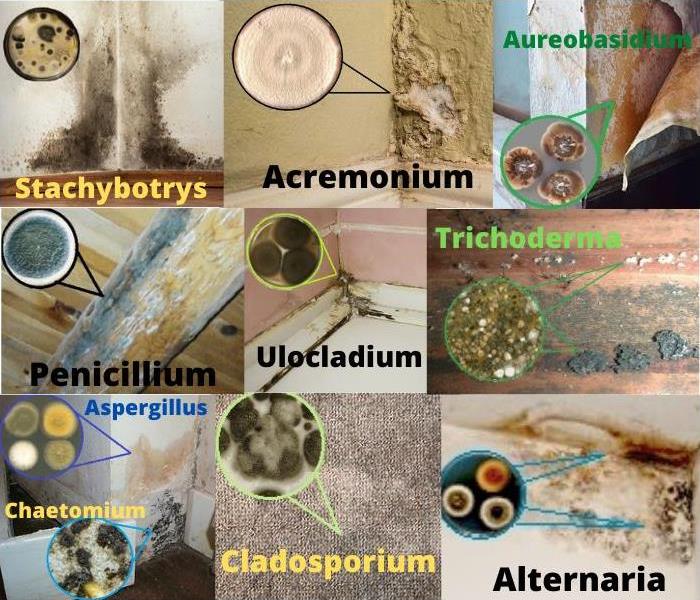Mold Types and Classifications
1/8/2021 (Permalink)
 This picture gives you a view of the various common molds and where they can grow. It also shows what the spores look like under a microscope.
This picture gives you a view of the various common molds and where they can grow. It also shows what the spores look like under a microscope.
There are three- (3) classifications of mold and various types in our world. This is a listing of the most common molds that can be found in our homes.
MOLD CLASSIFICATIONS:
- Allergenic
- Pathogenic
- Toxigenic
COMMON MOLD TYPES:
ACREMONIUM
- Classification: Pathogenic and Toxigenic mold type that evolves in its appearance over time
- Found: Typically grows in humidifiers, cooling coils, drain pans, and window sealants
ALTERNARIA
- Classification: Allergenic
- Found: Carpets, wallpaper, window frames, and air conditioning systems
ASPERGILLUS (Fumigatus – Flavus – Terreus - Niger – Nidulans)
- Classification: Allergenic and Toxigenic. There are over 185 species that appear in many different colors
- Found: Common mold found in American households’ walls and surfaces
AUREOBASIDIUM
- Classification: Allergenic
- Found: Can sometimes be found growing behind wallpaper or on painted or wooden surfaces, grout and/or caulking
CHAETOMIUM
- Classification: Allergenic or Pathogenic. Has a cotton-like texture and usually changes colors over time
- Found: Commonly found in water-damaged homes and buildings.
CLADOSPORIUM
- Classification: Allergenic or Pathogenic. Can grow in both warm and cold conditions
- Found: Areas with no sunlight and poor ventilation. Often found thriving in indoor materials such as fabrics, upholsteries, and carpets
MUCOR
- Classification.: Allergenic form of mold that usually grows in thick patches
- Found: Grows near air conditioning, HVAC systems. and ducting due to moisture from condensation, dust, carpets, and mattresses
PENICILLIUM
- Classification: Allergenic form of mold that is easily recognizable by its blue or green colored surface with a velvety texture
- Found: Often found in water-damaged buildings
STACHYBOTRYS
- Classification: Toxigenic. Also known as the nefarious “black mold”
- Found: Thrives in damp, wet areas with high humidity levels. Such as bathrooms, ceilings, wet carpets, laundry rooms, and basements
TRICHODERMA
- Classification: Allergenic mold type that is generally white with green patches
- Found: Commonly grows in the home on wet surfaces and moist areas. Such as Carpets, wallpaper, wooden furniture, and floors
ULOCLADIUM
- Classification: Allergenic
- Found: Thrives in the air and damp places. It is usually black. Can be found in kitchens, bathrooms, basements, and around windows with high condensation levels
It is always best to have a professional to test the structure and air quality. The professionals are called Environmental Hygienist. They can determine which mold and will give you a protocol on how to proceed with the mitigation process.
We are SERVPRO of Winnetka/Wilmette/Skokie are the professionals that will mitigate the mold and make your home safe again. We are here to put your mind at ease and walk you through the entire process. So call us at 847.600.0102.

 24/7 Emergency Service
24/7 Emergency Service